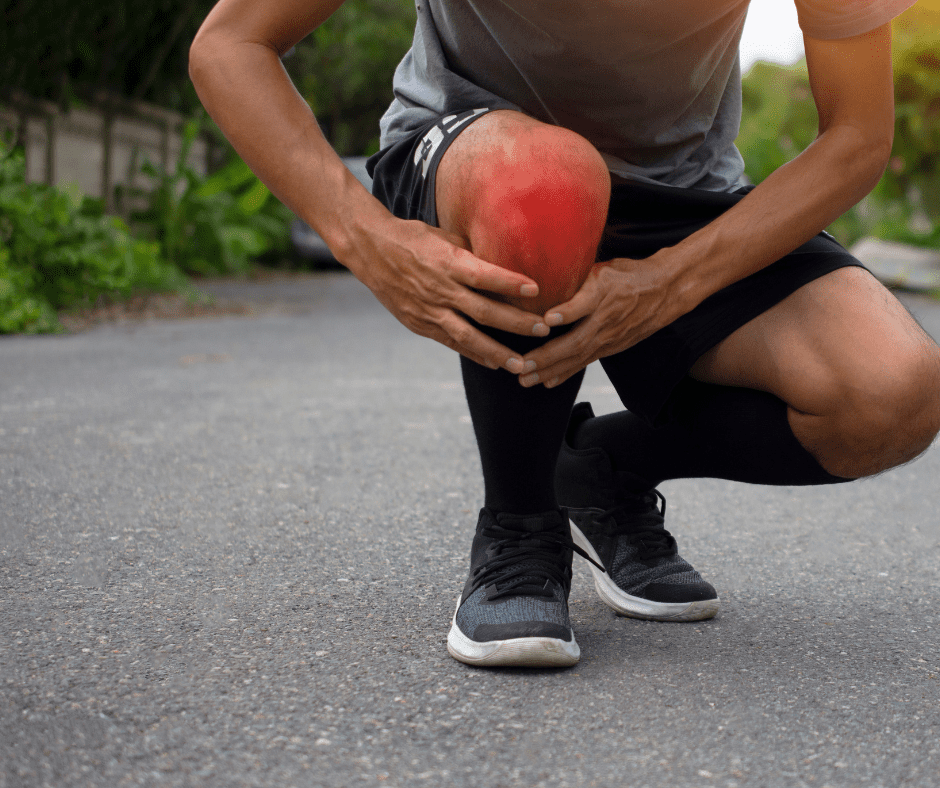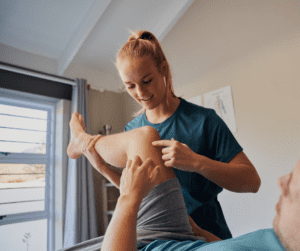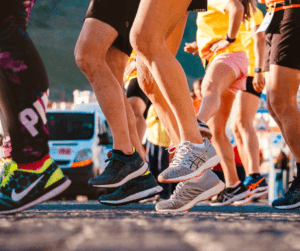A lot of people don’t know that the term “Runners Knee” is a broad term used to describe the pain you feel if you have one of several knee problems.
You might have heard a doctor call it Patellofemoral pain syndrome.
Patellofemoral pain syndrome can be better understood as…
Pain around the front of the knee (patella). This is where the knee connects with the lower end of the thigh bone (femur).
Let’s have a deeper look into Patellofemoral pain or… more commonly known as runner’s knee…

What Is Runners Knee?
Most of the big five fall into the overuse category, but like shin splints, runners knee or patella-femoral knee pain, in particular, does come down to people building up too quickly.
We have got four muscles that make up our quadriceps, (quad meaning four).
You’ve got a little guy called the Vastus Medialis oblique which is primarily responsible for stabilizing your patella.
Then you’ve got some pretty big muscles too…
The point is when you’ve been inactive for some time your proprioception or the body’s ability to adjust itself to protect the joints is one of the things that becomes the most compromised.
Those big quad muscles will stay quite big and they will work quite well but your Vastus Medialis oblique is probably not going to work so well.
This results in some misalignment with your patella tracking. Particularly If you build up too quickly and you don’t give your body a chance for that Vastus Medialis oblique to start activating as it should and to start getting a little bit stronger… in a nutshell, it will lead to problems such as pain, particularly in and around your knee cap.

Similarly, if you have some biomechanical issues you may pick up Runner’s knee…
Your quadriceps run into your patella tendon and your quadriceps tendon runs over and around the patella and becomes the patella tendon that joins the leg on the tibia or below the knee.
If you have some imbalances or problems with biomechanics in particular then you can get that pulling on the patella at an angle and that can also cause you some patella-femoral pain or some irritation of the knee cap.
It may seem obvious but if you are going to start running in squash shoes or in the shoes you had in high school, you are going to run into problems.

Often when people who have been running for years develop Runners knee or patella-femoral knee pain it is very often in response to their shoes.
This Is How To Tell You Need New Running Shoes
The knee is one of those joints that really needs to work in one plane.
Your knee joint opens and closes, which is pretty much what it does. Where you have other joints like your ankle or your hip and they’re a little more forgiving because they move in multiple directions…
So if imbalance creeps in or if there is another injury and you come back from that injury but it has caused some change or shift in your running gait and you finally find yourself in a position where you are landing on the ground and your knee is no longer able to move in just that straight plain thereby causing a bit of stress on the knee….That could also potentially cause patella-femoral knee pain.
Symptoms Of Runners Knee

There are 3 main symptoms of Runner’s knee.
- Pain
- Pain in/ around your kneecap that happens when you are exercising.
- As well as pain after sitting for a long time with the knees bent.
- Grinding Sounds
- Rubbing, grinding, or clicking sound of the kneecap that you hear when you bend and straighten your knee.
- Tender Kneecap
- If your Kneecap is tender to the touch.
How Is Runner’s Knee Diagnosed?
Healthcare providers can diagnose Runner’s knee by looking at your health history and by conducting a physical exam, possibly using an X-ray machine.
Let’s have a look at some of the main reasons why you could experience Runner’s knee…
Causes Of Runners Knee
- Overtraining
- An Imbalance
- Not Warming Up Correctly
- Knee Trauma
Overtraining
Long periods of overtraining can cause runner’s knee in even the most experienced athletes. This is why proper recovery is so important.
By not recovering properly, and if you continue to follow your running program without strategically planning rest days, you are at risk of injuries like patellofemoral syndrome.
An Imbalance
Our knees sit between our ankles and hips, so if there is an imbalance or dysfunction in either our ankles or our hips… there is a higher chance that we will experience runners knee.
Not Warming Up Correctly
If you want to avoid getting injured as a runner, only running is not enough!
In the video below, we walk you through exactly what to do before every run that you do.
It only takes a few minutes but if you start doing this as part of your pre-run routine, you can save yourself a lot of time and heartache down the line because of training missed due to injuries
Knee Trauma
When an accident happens and it involves a direct impact on your kneecap… it can lead to inflammation and therefore Runner’s knee.
Now that we know the causes of Runner’s knee, the good news is that it is treatable!
How To Treat Runners Knee
Firstly and very importantly, rest.
We then need to wake up that Vastus Medialis oblique and that is not a difficult thing to do…
It’s done in two ways:
Strength Exercises
This would involve 30-degree squats (or even less if there is a pain), a little pain-free range of motion such as single-leg squats, single-leg press-ups, and step-ups onto a very low step at first.
We’ll have a detailed look at strength training exercises for Runner’s knee in the next section.
Work On The Proprioception Simultaneously
The easiest way to do this is to stand on a thick carpet or rug, balance on one leg, and close your eyes.

That will throw yourself completely out of kilter and all the muscles in your ankle, in your bum, and around the knee that are supposed to stabilize those joints will be forced to engage better because there will be an exaggeration of the movement.
As you repeat that over time, that loss of balance will get smaller and smaller as those proprioceptors do their job, your Vastus Medialis oblique will be doing its job better and your runner’s knee or patella-femoral knee pain shouldn’t be bothering you anymore.
As we mentioned above, our strength & conditioning expert Shona Hendricks talks about what strength training you can do to prevent Runner’s knee.
Strength Training for Runner’s Knee
To prevent knee pain when running, download our free strength program here.




Comments are closed.